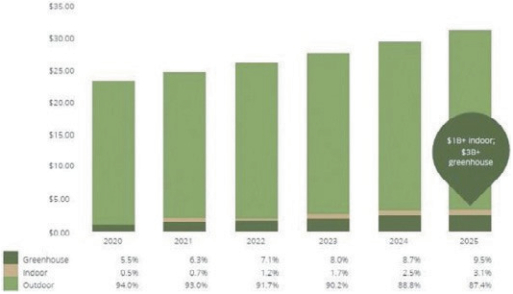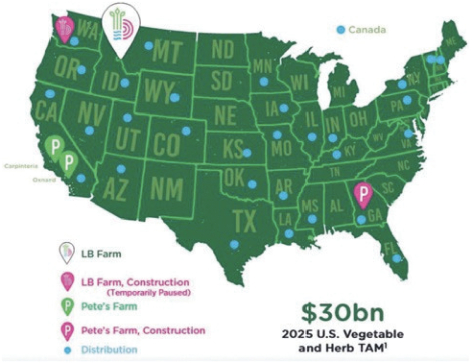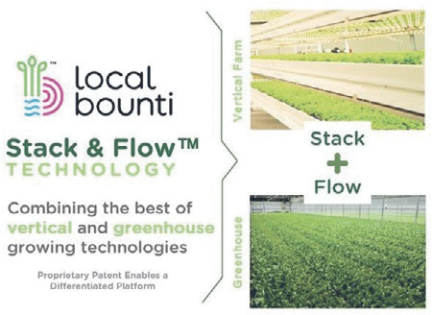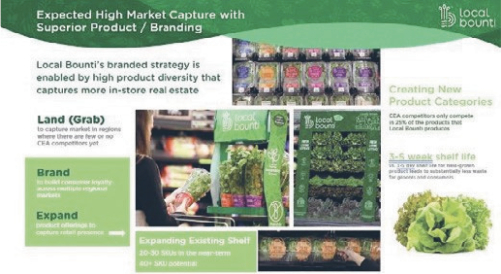As filed with the Securities and Exchange Commission on June 17, 2022.
Registration No. 333-
UNITED STATES
SECURITIES AND EXCHANGE COMMISSION
Washington, D.C. 20549
FORM S-1
REGISTRATION STATEMENT
UNDER
THE SECURITIES ACT OF 1933
(Exact Name of Registrant as Specified in Its Charter)
Delaware |
0182 |
98-1584830 | ||
| (State or Other Jurisdiction of Incorporation or Organization) |
(Primary Standard Industrial Classification Code Number) |
(I.R.S. Employer Identification Number) |
220 W. Main St.
Hamilton, MT 59840
(800) 640-4016
(Address, Including Zip Code, and Telephone Number, Including Area Code, of Registrant’s Principal Executive Offices)
| Craig M. Hurlbert Co-Chief Executive Officer 220 W. Main St. Hamilton, MT 59840 (800) 640-4016 |
Travis M. Joyner Co-Chief Executive Officer 220 W. Main St. Hamilton, MT 59840 (800) 640-4016 |
(Name, Address, Including Zip Code, and Telephone Number, Including Area Code, of Agent for Service)
Copies to:
| Albert W. Vanderlaan, Esq. Orrick Herrington & Sutcliffe LLP 222 Berkeley Street Suite 2000 Boston, MA 02116 (617) 880-1800 |
Kathleen Valiasek Chief Financial Officer Local Bounti Corporation 220 W. Main St. Hamilton, MT 59840 (800)640-4016 |
Approximate date of commencement of proposed sale to the public:
If the only securities being registered on this Form are being offered pursuant to dividend or interest reinvestment plans, please check the following box. ☐
If any of the securities being registered on this Form are to be offered on a delayed or continuous basis pursuant to Rule 415 under the Securities Act of 1933, other than securities offered only in connection with dividend or interest reinvestment plans, check the following box. ☒
If this Form is filed to register additional securities for an offering pursuant to Rule 462(b) under the Securities Act, please check the following box and list the Securities Act registration statement number of the earlier effective registration statement for the same offering. ☐
If this Form is a post-effective amendment filed pursuant to Rule 462(c) under the Securities Act, check the following box and list the Securities Act registration statement number of the earlier effective registration statement for the same offering. ☐
If this Form is a registration statement pursuant to General Instruction I.D. or a post-effective amendment thereto that shall become effective upon filing with the Commission pursuant to Rule 462(e) under the Securities Act, check the following box. ☐
If this Form is a post-effective amendment to a registration statement filed pursuant to General Instruction I.D. filed to register additional securities or additional classes of securities pursuant to Rule 413(b) under the Securities Act, check the following box. ☐
Indicate by check mark whether the registrant is a large accelerated filer, an accelerated filer, a non-accelerated filer, a smaller reporting company, or an emerging growth company. See the definitions of “large accelerated filer,” “accelerated filer,” “smaller reporting company,” and “emerging growth company” in Rule 12b-2 of the Exchange Act.
Large accelerated filer |
☐ |
Accelerated filer |
☐ | |||
☒ |
Smaller reporting company |
|||||
Emerging growth company |
||||||
If an emerging growth company, indicate by check mark if the registrant has elected not to use the extended transition period for complying with any new or revised financial accounting standards provided pursuant to Section 7(a)(2)(B) of the Securities Act. ☐
The registrant hereby amends this registration statement on such date or dates as may be necessary to delay its effective date until the registrant shall file a further amendment which specifically states that this registration statement shall thereafter become effective in accordance with Section 8(a) of the Securities Act of 1933, as amended, or until the registration statement shall become effective on such date as the Securities and Exchange Commission, acting pursuant to said Section 8(a), may determine.
The information in this preliminary prospectus is not complete and may be changed. The securities may not be sold until the registration statement filed with the Securities and Exchange Commission is effective. This preliminary prospectus is not an offer to sell these securities and is not soliciting an offer to buy these securities in any jurisdiction where the offer or sale is not permitted.
Subject to Completion. Dated June 17, 2022.

Local Bounti Corporation
Up to 7,587,531 Shares of Common Stock
This prospectus relates to the offer and sale from time to time by the selling stockholders named in this prospectus (the “Selling Stockholders”) of up to 7,587,531 shares of our common stock, par value $0.0001 per share (the “Common Stock”). The shares of Common Stock covered by this prospectus were previously issued by us, of which (1) 5,654,600 shares of Common Stock was issued in connection with the Pete’s Acquisition (as defined below). and (2) 1,932,931 shares of Common Stock issued in connection with our First Amendment to Credit Agreements and Subordination Agreement among us, certain other of our subsidiaries, and Cargill Financial Services International, Inc. (the “Cargill Financial”), dated as of March 14, 2022. On April 4, 2022, Local Bounti closed the transactions contemplated by: (a) a Purchase and Sale Agreement (the “PSA”) dated March 14, 2022 by and among (i) the Hollandia Produce Group, Inc. Employee Stock Ownership Trust (the “Share Seller”), (ii) Mosaic Capital Investors I, LP, a Delaware limited partnership (“Mosaic”), True West Capital Partners Fund II, L.P. f/k/a Seam Fund II, L.P., a Delaware limited partnership (“TWC” and collectively with Mosaic and the Share Seller, the “Sellers” and each individually, a “Seller”), (iii) Mosaic Capital Investors LLC, a Delaware limited liability company (the “Sellers’ Representative”), solely in its capacity as Sellers’ Representative, (iv) Hollandia Produce Group, Inc., a California corporation (the “Target” or “Pete’s”), (v) Local Bounti Operating Company LLC, a Delaware limited liability company and a wholly-owned subsidiary of the Company (“Purchaser”), and (vi) the Company, pursuant to which Purchaser acquired all of the issued and outstanding shares of capital stock and rights to acquire capital stock of the Target at the closing of the transactions contemplated by the PSA, the Georgia UPA (as defined below) and the Georgia Corporation PSA (as defined below) (the “Closing”), (b) a Unit Purchase Agreement (the “Georgia UPA”) dated March 14, 2022 by and among the Company, Purchaser and each of the holders of Class B Common Units of the Georgia Company (each, a “Georgia Share Seller”), providing for the acquisition by Purchaser at the Closing of all of the issued and outstanding Class B Common Units of Hollandia Produce GA, LLC, a Delaware limited liability company, and a majority-owned subsidiary of the Target (the “Georgia Company”), and (c) a Stock Purchase Agreement (the “Georgia Corporation PSA,” and collectively with the Georgia UPA and the PSA, the “Purchase Agreements”) dated March 14, 2022 by and among the Company, Purchaser, Mosaic and TWC (Mosaic and TWC, together with the Sellers and the Georgia Share Sellers, the “Selling Parties”), providing for the acquisition by Purchaser at the Closing of all of the issued and outstanding shares of capital stock of Hollandia Produce GA Investor Corporation, a Delaware corporation (the “Georgia Corporation”), holding all of the issued and outstanding Series A Preferred Units of the Georgia Company. Pursuant to the Purchase Agreements, the Company (through Purchaser) acquired all of the equity interests and rights to acquire equity interests of the Target and its subsidiaries, including the minority interest in the Georgia Company not owned by the Target, from the Selling Parties (collectively, the “Pete’s Acquisition”).
We are registering the securities described above for resale pursuant to, among other things, the Selling Stockholders’ registration rights under certain agreements between us and the Selling Stockholders. Our registration of the securities covered by this prospectus does not mean that either we or the Selling Stockholders will issue, offer or sell, as applicable, any of the securities. The Selling Stockholders may offer, sell or distribute all or a portion of the securities hereby registered publicly or through private transactions at prevailing market prices or at negotiated prices. We provide more information about how the Selling Stockholders may sell or otherwise dispose of their shares of Common Stock in the section entitled “Plan of Distribution” on page 146 of this prospectus. We will bear all costs, expenses and fees in connection with the registration of these shares, including with regard to compliance with state securities or “blue sky” laws. The Selling Stockholders will bear all commissions and discounts, if any, attributable to their sale of shares of Common Stock.
Our Common Stock and Public Warrants are listed on the New York Stock Exchange under the symbols “LOCL” and “LOCL WS,” respectively. On June 16, 2022, the last reported sales price of the Common Stock was $3.67 per share and the last reported sales price of our Public Warrants was $0.5321 per warrant.
We are an “emerging growth company” as defined in Section 2(a) of the Securities Act of 1933, as amended, and, as such, have elected to comply with certain reduced disclosure and regulatory requirements.
Investing in our securities involves risks. See the section entitled “Risk Factors” beginning on page 7 of this prospectus to read about factors you should consider before buying our securities.
Neither the Securities and Exchange Commission nor any state securities commission has approved or disapproved of these securities or determined if this prospectus is truthful or complete. Any representation to the contrary is a criminal offense.
The date of this prospectus is , 2022.








